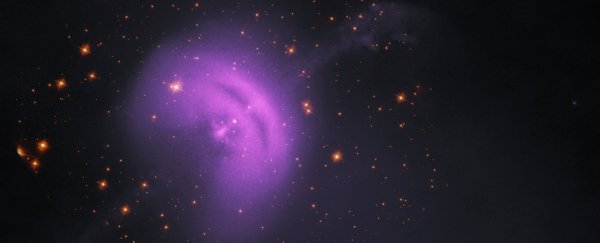A peculiar hiccup in the rotation speed of a dead star has turned out to be even more interesting than we thought. For the first time, astronomers have shown that the rotation of the Vela pulsar slowed down immediately before its 2016 glitch.
Not only was this completely unexpected, it could help us narrow down the mysterious dynamics in the ultradense interiors of neutron stars.
For astronomers, some of the most useful objects in the Universe are rapidly rotating neutron stars known as pulsars. As they rotate, they flash out a beam of radiation like a lighthouse, often on incredibly fast and regular timescales.
This can be useful for a whole range of science applications, but even pulsars aren't 100 percent precise. Over time, they gradually lose a small amount of rotational energy, ever-so-slightly slowing down. Every now and again however, they can suddenly speed up before returning to normal - that's what we call a glitch.
We don't know what causes pulsar glitching, but astronomers believe it has something to do with the neutron star's internal processes.
And this is where the Vela pulsar, located around 1,000 light-years from Earth, comes in. It normally spins at a rate of about 11 rotations per second. But it's also a well-known serial glitcher, hiccuping once every three years or so. (Its most recent glitch was in February of this year, but this research concerns the previous glitch, in December 2016.)
These glitches can't be predicted, but their relative regularity means we have a better chance of catching one in the act, which is what happened in December 2016, when, for the first time, the glitch was recorded in real time using a radio telescope.
The first analysis of that glitch revealed changes in the pulse shape during the glitch event. Now a deeper analysis has revealed that, during the glitch, the pulsar starting spinning even faster - what is known as a rotational-frequency overshoot - and then relaxed back down to a more normal speed pretty quickly.
This is consistent with theoretical models that suggest there are three components to the internal structure of a neutron star.
"One of these components, a soup of superfluid neutrons in the inner layer of the crust, moves outwards first and hits the rigid outer crust of the star, causing it to spin up," said astrophysicist Paul Lasky of Monash University in Australia.
"But then, a second soup of superfluid that moves in the core catches up to the first causing the spin of the star to slow back down. This overshoot has been predicted a couple of times in the literature, but this is the first real time it's been identified in observations."
It's not conclusive proof that this is indeed what's happening inside neutron stars, but it does bring us a little closer to narrowing it down.
That slowdown we mentioned earlier, though, still defies explanation. The researchers noted in their paper that the slowdown may actually trigger the glitch by causing a critical lag between the crust and the crustal superfluid, but there's still a giant question mark hanging over it.
"Immediately before the glitch, we noticed that the star seems to slow down its rotation rate before spinning back up," said astronomer and physicist Greg Ashton of Monash University.
"We actually have no idea why this is, and it's the first time it's ever been seen."
But, while the mystery remains, the analysis does show that the glitch is a bit more complex than a short, single-step process. The team hopes that future observations, analysis and theoretical modelling will come up with new explanations for the dynamics they have revealed.
The research has been published in Nature Astronomy.
